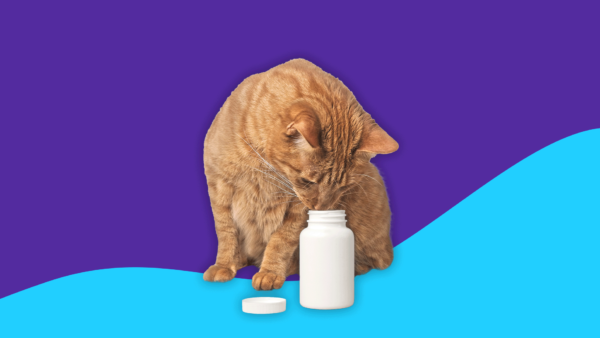Chances are, you or someone you know has taken the prescription medication amoxicillin for an infection. The penicillin antibiotic is one of the best-known and commonly used remedies for human infections, whether caused by injuries, illnesses, or other germs. But what about our four-legged friends?
Pets, including dogs, are also prone to infection from various sources—but can dogs take amoxicillin? Generally yes, but if your veterinarian will prescribe it depends on several factors, like the type of infection your dog has, their health history, and the effectiveness of antibiotics on your dog in the past. Here’s what you should know about amoxicillin for dogs, including the proper dosage and possible side effects.
What is amoxicillin used for in dogs?
Just like humans, dogs can take antibiotics for bacterial infections, and veterinarians often reach for amoxicillin, among other medications. “Vets prescribe many types of antibiotics, including amoxicillin,” says Chyrle Bonk, DVM, a veterinary writer and consultant in Orofino, Idaho. “Dogs are given antibiotics to help treat a variety of bacterial infections and to prevent secondary bacterial infections that can coincide with viral infections.”
Amoxicillin is a broad-spectrum antibiotic that is commonly used in dogs for urinary tract infections (UTI), pneumonia, respiratory tract infections, and skin infections. It can also be used preventively to prevent infection after a bite from another dog.
Other antibiotics used in veterinary medicine for dogs include:
If you’re not sure your dog has an infection, take them to the vet so they can determine the best and safest course of action. It’s possible your dog is sick but with something viral or a chronic health condition—which antibiotics would not help.
“Though it is common for human-labeled amoxicillin to be used in dogs, it is a prescription medication and should be used only under the guidance of your veterinarian,” says Don LeHoullier, DVM and CareCredit partner. This means you shouldn’t give your pet amoxicillin from your own medicine cabinet. Getting the proper diagnosis and treatment is instrumental in helping your pet feel better as quickly as possible.
Amoxicillin dosage for dogs
“Amoxicillin can be very effective for certain types of infections if given at the proper dosage and duration,” Dr. Bonk says. It’s also generally inexpensive.
The recommended dosage of amoxicillin for dogs also varies based on several factors. “The amoxicillin dose for your dog will depend on their size and the condition being treated,” Dr. Bonk says. “Your vet will calculate the dose based on these two conditions.”
In general, your vet will prescribe a 5 mg per pound dose of amoxicillin twice daily. So, if you have a 20-pound pup, he may receive 100 mg two times a day. The dose duration is an important factor in how well amoxicillin will work for your dog’s particular case.
Amoxicillin for dogs has the same active ingredient as the human medication and comes in a few forms, including tablets and injections. “Small dogs will commonly be prescribed an oral liquid that allows for smaller dosages and larger dogs will typically be prescribed capsules or sometimes tablets,” says Dr. LeHoullier. Your vet will determine the best form depending on how likely your dog is to accept a pill, the severity of the infection, and other underlying health conditions.
Tablets can be administered at home; if your dog won’t eat the medicine directly, you can use a pill pocket treat or hide the amoxicillin in a favorite food. Injections typically need to be administered by a medical professional in your veterinarian’s office, but they’re a good choice for severe infections because they take effect more quickly.
If your provider prescribes a tablet that is also available for humans, you can fill it at your own pharmacy. (To help you save on the medication, be sure to use a SingleCare coupon.) There are also canine-specific brand name amoxicillin, including:
- Amoxi-Tabs
- Amoxi-Drops
- Bimox
- Novamoxin
Amoxicillin for dogs’ side effects
Besides being effective and affordable, many vets prefer amoxicillin over other drugs because of the lack of side effects. However, like most antibiotics, there are a few common side effects of amoxicillin, mostly affecting the gastrointestinal system. “Amoxicillin may cause some stomach issues for your pup, especially if given on an empty stomach,” Dr. Bonk says.
Side effects include:
- Upset stomach
- Reduced appetite
- Vomiting
- Diarrhea
- Abdominal pain
If your dogs’ side effects are severe or very uncomfortable, ask your vet if probiotics or a particular diet could help. Side effects “can be minimized by giving the medication with food and following the instructions on the prescription label,” says Dr. Teegan Wheaton, Owner and Medical Director of GoodVets Castle Rock, set to open next month in Denver.
Signs of an allergic reaction include hives, skin rash, facial swelling, difficulty breathing, and trouble walking. The antibiotic stays in the system for 24 hours in most cases, so side effects should abate by then, but “If your dog is experiencing discomfort while on amoxicillin, you should contact your veterinarian immediately,” says Dr. Wheaton. The good news is, your pup is likely to feel better shortly after you start giving them the medicine.
“After oral administration, it takes amoxicillin about 1.5-2 hours to reach therapeutic concentrations in the body,” says Dr. Wheaton. However, “While these concentrations may be reached in a couple hours, it may take several doses over several days to get the desired effects of the drug. That is why it is important to follow the dosing instructions exactly as directed by the veterinarian and follow up with them if you feel the infection is not fully treated,” she says. If your pet is not improving after a couple of days, take them back to the vet. They may need a different antibiotic or course of treatment.
Even if your dog seems to be feeling totally better after one or two doses, be sure to give them the entire course prescribed. Just like in humans, stopping the medicine early can lead to antibiotic resistance and the infection coming back; necessitating a stronger, different drug that could have more severe side effects. It’s also possible for your dog to be asymptomatic but still infectious, spreading bacteria to other dogs.
Is amoxicillin safe for dogs?
While amoxicillin is generally considered safe for dogs, there are some drug interactions to be aware of. “Amoxicillin can interact with other antibiotics and some immunosuppressive medications,” Dr. Bonk says.
It’s important to give your vet your dog’s full health history, including any medications or supplements your dog is taking. If your pet has had this type of infection before, mention it and note which antibiotic they received, how they reacted to it, and if it worked well or if a second drug was needed.
Many people are allergic to penicillin and its relatives, including amoxicillin. While it is very uncommon for dogs to have similar allergies and adverse reactions, it is possible.
“Dogs can develop an allergy to amoxicillin,” Dr. Bonk says. “Dogs that are allergic may show up with redness and swelling of the face, a fever, difficulty breathing, or incoordination. If you notice any of these signs in your dog, discontinue use and contact your vet immediately.”
Sources
- Prevention and Treatment of Dog Bites. American Academy of Family Physicians (2001)
- Amoxicillin. VCA Animal Hospitals
- Amoxicillin for Dogs: Safety, Usage, Dosage and More. Veterinarians.org (2023)











